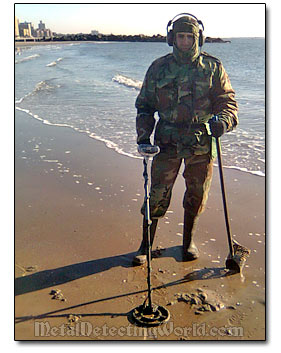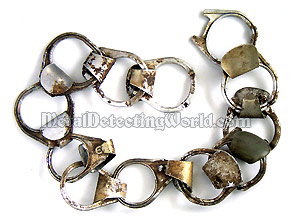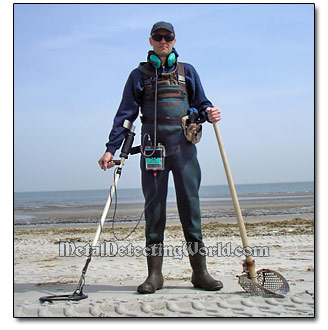Types of Metal Detecting Activities, page 14:
BEACH HUNTING, Beach Combing: General Information, Tips
(CONTINUED from previous page)
CATEGORIES OF BEACH HUNTERS
Since beach hunting encompasses many different tasks, and beach detectorists use various search techniques and styles for accomplishing their goals, the categories of beach hunters listed below may easily overlap. However, by considering major principles and search methods used in beach hunting, beach hunters can be divided into five main categories:

1) Recreational Beachcombers - hobby enthusiasts who look for any "keeper" finds besides jewelry and coins. They operate their metal detectors either in All Metal mode or with Discrimination; it depends on personal preferences or types of metal detectors they use. Recreational beachcombers believe that speed is the key, and it is all just a matter of percentages: the faster you recover various targets, the faster you find gold among them.
2) Professional Beachcombers who operate their detectors in All Metal mode only. Unless they hunt the beach which is really trashed, many experienced beach hunters do not utilize any Discrimination. They believe that a beach hunter using discrimination is more likely to miss some valuable treasures than one who is operating his/her metal detector in All Metal mode and digging all targets. Their principle is also based on percentages: the more targets you recover, the more chances you have in finding something valuable. Some beachcombers say that they do not mind to use All Metal mode because digging up targets in sand is easy.
Well, when it comes to covering a vast area, lots of digging through the dry sand first and then wet sand and pebbles while trying to get to the deepest targets that include many junk items, dealing with numerous pull-tabs and foil wads besides other undesirable finds, one has no choice but to start making every effort to conserve energy for recovering valuable targets.
This would compel a beach hunter to switch off the All Metal mode and use some Discrimination before anything else; thus, loosing some operational depth range - a common problem of most VLF metal detectors. Today, there are some advanced metal detectors on the market that allow a detectorist to save time and energy by using the Multiple Tone ID and Discrimination options without losing operational depth range and missing small gold jewelry. Advanced technology provides an excellent separation of desirable targets from ferrous junk; thus, allowing a metal detector to "recognize" the targets that are partially masked by iron.

3) Beach Gold Hunters who seek only the gold jewelry. By utilizing the proper "Notch" or "Dot" Discrimination patterns, they ignore everything else or just the targets positioned above the gold's range on a conductivity scale. FBS technology allows them to discriminate nickels and most types of pull-tabs without missing out on gold. Or they learn most of the "gold" signals by means of the Tone ID which helps them decide whether to dig or not.
Beach gold hunters especially focus on "faint" signals emitted by gold items that usually sink through the sand deep down to the layer of hard clay or layer of rock which generally underlies most mud or sand beaches. Winter heavy erosion removes the thick upper layer of sand and makes the gold jewelry more accessible for metal detectors. Erosion also exposes the lowest depressions where gold jewelry is accumulated - "gold pockets." Professional beach gold hunters discover such "treasure troves" when "the timing is right." They closely "watch" the beach during the winter months (see "When To Beach Hunt" on next page for more details).

Digging up silver jewelry and coins is considered unproductive and not profitable by beach gold hunters unless they search 1) old beaches that may contain collectible gold, silver and copper coins, old rose gold and silver jewelry and other vintage valuables, and/or 2) beaches that are situated at or near locations of the early shipwrecks (the US coasts are dotted by them!) and, therefore, may yield a good number of ancient coins, relics and jewelry.
4) Beach Coin Shooters who set up the Discrimination controls to ignore everything below the large pull-tabs on a conductivity scale, or rely on the Multiple Tone ID to pick up only the "solid" signals emitted by the targets of high conductivities - copper, clad and silver coins and silver jewelry, and not to be bothered with numerous junk targets. Rarely they find a large gold ring if they are lucky.
Searching just for modern coins on the beach can be very productive 1) at extremely crowded beach if you hunt it at the end of the day when the beach is still "hot," and 2) at the beaches located in less developed countries where beach goers do not wear much of gold jewelry but still loose many coins, and metal detectors have never been seen there.
5) Non-Detecting Beachcombers who do not use metal detectors. As there is always plenty of flotsam (goods lost from the sunken ship, which are recoverable because they have floated), jetsam (goods cast overboard in order to lighten a vessel which was in danger of sinking) and other refuse, they walk along the water line and try to eyeball anything valuable. Often, it is merely trash, but sometimes, especially after the storm, they spot a beautiful seashell, a priceless bracelet or a nice Spanish silver "Piece of Eight" (if they search the beach in the Florida Keys). Their principle is to look for a metallic gleam or dark and misshapen objects such as encrusted and oxidized silver, or any other unusual and "out of place" objects.